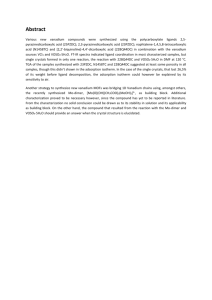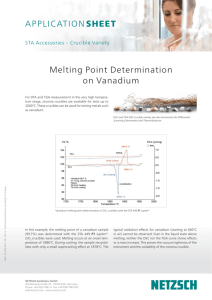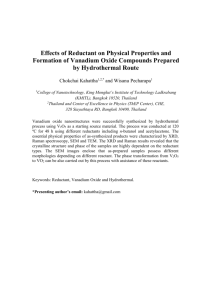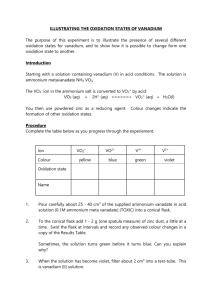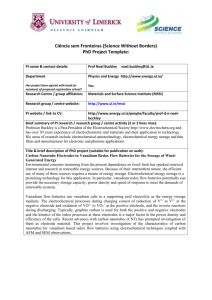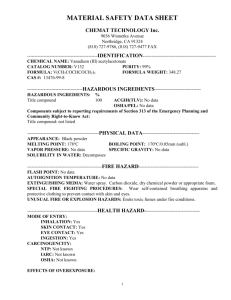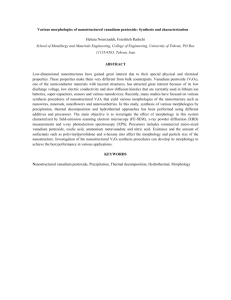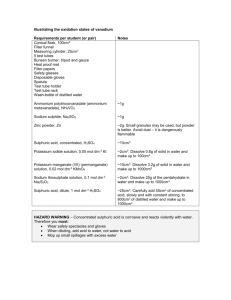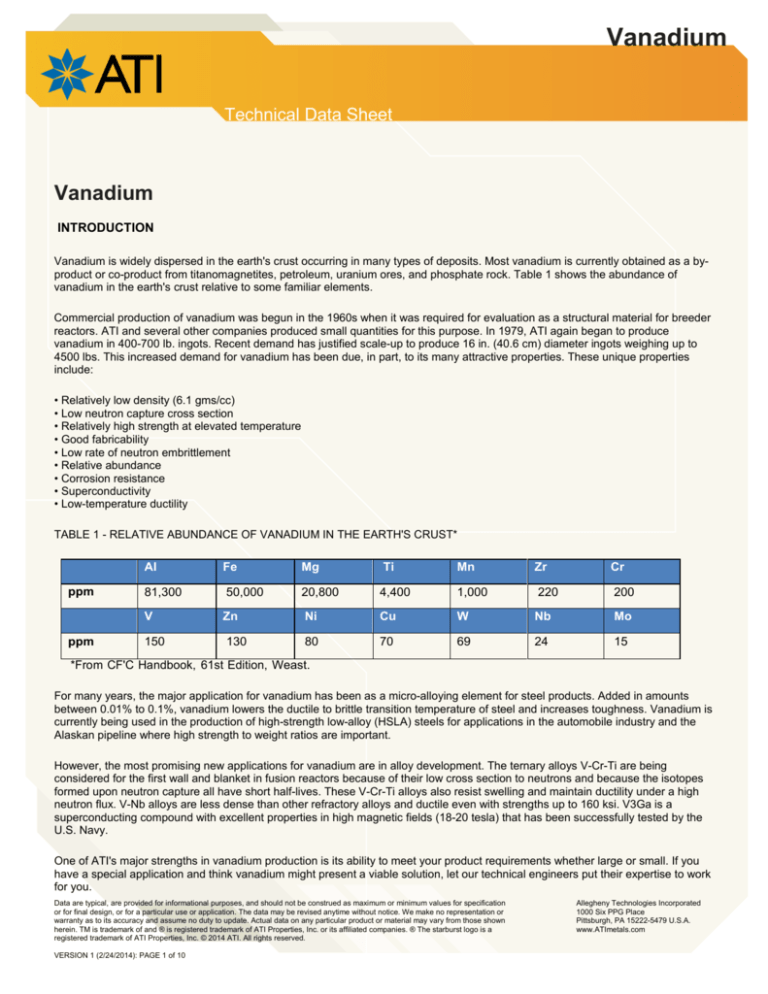
Vanadium
Technical Data Sheet
Vanadium
INTRODUCTION
Vanadium is widely dispersed in the earth's crust occurring in many types of deposits. Most vanadium is currently obtained as a byproduct or co-product from titanomagnetites, petroleum, uranium ores, and phosphate rock. Table 1 shows the abundance of
vanadium in the earth's crust relative to some familiar elements.
Commercial production of vanadium was begun in the 1960s when it was required for evaluation as a structural material for breeder
reactors. ATI and several other companies produced small quantities for this purpose. In 1979, ATI again began to produce
vanadium in 400-700 lb. ingots. Recent demand has justified scale-up to produce 16 in. (40.6 cm) diameter ingots weighing up to
4500 lbs. This increased demand for vanadium has been due, in part, to its many attractive properties. These unique properties
include:
• Relatively low density (6.1 gms/cc)
• Low neutron capture cross section
• Relatively high strength at elevated temperature
• Good fabricability
• Low rate of neutron embrittlement
• Relative abundance
• Corrosion resistance
• Superconductivity
• Low-temperature ductility
TABLE 1 - RELATIVE ABUNDANCE OF VANADIUM IN THE EARTH'S CRUST*
ppm
ppm
Al
Fe
Mg
Ti
Mn
Zr
Cr
81,300
50,000
20,800
4,400
1,000
220
200
V
Zn
Ni
Cu
W
Nb
Mo
150
130
80
70
69
24
15
*From CF'C Handbook, 61st Edition, Weast.
For many years, the major application for vanadium has been as a micro-alloying element for steel products. Added in amounts
between 0.01% to 0.1%, vanadium lowers the ductile to brittle transition temperature of steel and increases toughness. Vanadium is
currently being used in the production of high-strength low-alloy (HSLA) steels for applications in the automobile industry and the
Alaskan pipeline where high strength to weight ratios are important.
However, the most promising new applications for vanadium are in alloy development. The ternary alloys V-Cr-Ti are being
considered for the first wall and blanket in fusion reactors because of their low cross section to neutrons and because the isotopes
formed upon neutron capture all have short half-lives. These V-Cr-Ti alloys also resist swelling and maintain ductility under a high
neutron flux. V-Nb alloys are less dense than other refractory alloys and ductile even with strengths up to 160 ksi. V3Ga is a
superconducting compound with excellent properties in high magnetic fields (18-20 tesla) that has been successfully tested by the
U.S. Navy.
One of ATI's major strengths in vanadium production is its ability to meet your product requirements whether large or small. If you
have a special application and think vanadium might present a viable solution, let our technical engineers put their expertise to work
for you.
Data are typical, are provided for informational purposes, and should not be construed as maximum or minimum values for specification
or for final design, or for a particular use or application. The data may be revised anytime without notice. We make no representation or
warranty as to its accuracy and assume no duty to update. Actual data on any particular product or material may vary from those shown
herein. TM is trademark of and ® is registered trademark of ATI Properties, Inc. or its affiliated companies. ® The starburst logo is a
registered trademark of ATI Properties, Inc. © 2014 ATI. All rights reserved.
VERSION 1 (2/24/2014): PAGE 1 of 10
Allegheny Technologies Incorporated
1000 Six PPG Place
Pittsburgh, PA 15222-5479 U.S.A.
www.ATImetals.com
Vanadium
Technical Data Sheet
SUPERCONDUCTING WIRE
The extremely high ductility of vanadium and niobium makes them useful in superconducting wire manufactured through the
Modified Jelly-Roll (MJR) process. The MJR and Tin Core MJR processes, both developed at ATI, allow a billet which contains all
the components of superconductors to be extruded and cold-drawn to final wire size without annealing. The billet to wire reductions
without annealing have routinely exceeded 100,000 to 1 and recently a wire was made which had been reduced by 1,000,000 to 1.
Pure vanadium has also been used as a diffusion-barrier to tin in Nb3Sn wires. The vanadium surrounds the zones containing
niobium filaments and tin or tin-bronze and prevents the tin from diffusing into the copper cladding. These superconducting wires
are being used in a variety of applications including superconducting magnets for medical diagnostic devices and for fusion reactor
research.
FUSION REACTOR TECHNOLOGY
The ternary alloys of V-Cr-Ti and V-Ti-Si are being evaluated for use in fusion reactors for the first wall and blanket structure. Pure
vanadium must be used to produce these alloys and may be important in producing other vanadium-containing alloys with improved
properties. The following properties make vanadium a leading candidate for this application:
• Low long-term activation
• High operating temperature
• High surface heat load capability
• Good liquid metal compatibility
• Good radiation damage resistance
Low long-term activation is a property of vanadium, chromium, titanium and silicon. Under a high flux of neutrons, radioisotopes of
vanadium, chromium and titanium are formed in the alloy. These radioisotopes have short half-lives which result in rapid radioactive
decay. This short decay-time allows for safer disposal than is possible with alloys containing many other elements. In the next few
decades, years, it is predicted that fusion energy may replace fission energy. Two important advantages of the fusion process are
that its fuel supply is almost inexhaustible and that it generates almost no radioactive waste if low-activation alloys, such as V-Cr-Ti,
are used in the first wall and blanket.
ALLOYS
Vanadium has been available for years for alloying as FeV or VA master-alloys. ATI’s pure vanadium allows production of alloys
which do not contain Fe or Al. The production of whole new families of alloys with different properties is now possible on a large
scale.
Pure vanadium and vanadium alloyed with chromium and titanium are very resistant to corrosion from liquid lithium or lithium-lead.
This property makes vanadium a prime candidate for liquid metal heat exchangers. At room temperature, vanadium and its alloys
have excellent resistance to corrosion in salt-water and dilute hydrochloric acid. Vanadium also exhibits good corrosion resistance
in sodium hydroxide solutions and resists attack by liquid alkali metals. V-Cr-Ti alloys have corrosion resistance to high temperature
water (240ºC) equal to the best stainless steels, and superior to stainless steels in stress corrosion cracking.
Vanadium and vanadium alloys are much lighter than most refractory metals. This property makes vanadium a logical choice for
applications where strength to weight ratios are important such as in the aerospace and aircraft industries. Of all the refractory
alloys, vanadium alloys have the highest strength to weight ratios.
One of our specialties at ATI is the ability to develop alloys to meet your specifications. If you have an unusual alloy requirement,
call us and we will be happy to help you in the developmental process.
ALUMINOTHERMIC REDUCTION
ATI produces vanadium through aluminothermic reduction of high purity vanadium pentoxide as follows:
Data are typical, are provided for informational purposes, and should not be construed as maximum or minimum values for specification
or for final design, or for a particular use or application. The data may be revised anytime without notice. We make no representation or
warranty as to its accuracy and assume no duty to update. Actual data on any particular product or material may vary from those shown
herein. TM is trademark of and ® is registered trademark of ATI Properties, Inc. or its affiliated companies. ® The starburst logo is a
registered trademark of ATI Properties, Inc. © 2014 ATI. All rights reserved.
VERSION 1 (2/24/2014): PAGE 2 of 10
Allegheny Technologies Incorporated
1000 Six PPG Place
Pittsburgh, PA 15222-5479 U.S.A.
www.ATImetals.com
Vanadium
Technical Data Sheet
1OAI+3V2 05 -------> 6V+5Al2 03
Excess aluminum is added to lower the oxygen content of the reduced metal and to increase the yield of vanadium The excess
aluminum also assists in the removal of oxygen during the subsequent electron beam melting.
ELECTRON BEAM MELTING
Electron beam melting is an accepted method for purifying refractory metals such as tantalum, niobium, and vanadium. The high
melting points and comparatively low vapor pressures allow purification by vaporization of impurities with higher vapor pressures.
Vanadium does not purify as readily as tantalum or niobium because of its lower melting point and higher vapor pressure; however,
purities of up to 99.9% can be achieved by melting the ingot several times.
TYPICAL COMPOSITION
Typical chemistry for current production commercial vanadium is given in Table 2.
TABLE 2 - TYPICAL CHEMISTRY FOR VANADIUM (COMMERCIAL)
ppm
ppm
0
N
H
C
P
S
Si
350
180
<5
60
<30
<20
400
Fe
Al
Cr
Mo
Nb
Ni
<400
300
<20
80
60
<20
Figures calculated by weight • Hardness BHN Average 60 (500Kg load)
MILL PRODUCTS
Vanadium, a soft and very ductile metal, is available in plate, sheet, foil, billet, bar, rod and wire. Tubing is available by special
order.
PHYSICAL PROPERTIES
Atomic Number
23
Atomic Weight
50.942
Density (g/cc at 200ºC)
6.1
3
(lbs./in )
0.221
Crystal Structure
body centered cubic
Laftice Parameters, Calcium reduced
3.0278
(Iodide)
3.0258
Recrystallization Temperature º C
800º to 1010ºC
Melting Point
1900ºC
Boiling Point
3400ºC
Data are typical, are provided for informational purposes, and should not be construed as maximum or minimum values for specification
or for final design, or for a particular use or application. The data may be revised anytime without notice. We make no representation or
warranty as to its accuracy and assume no duty to update. Actual data on any particular product or material may vary from those shown
herein. TM is trademark of and ® is registered trademark of ATI Properties, Inc. or its affiliated companies. ® The starburst logo is a
registered trademark of ATI Properties, Inc. © 2014 ATI. All rights reserved.
VERSION 1 (2/24/2014): PAGE 3 of 10
Allegheny Technologies Incorporated
1000 Six PPG Place
Pittsburgh, PA 15222-5479 U.S.A.
www.ATImetals.com
Vanadium
Technical Data Sheet
Coefficient of Linear Thermal Expansion
8.3 x 10-6
per ºC, 23º to 100ºC
Thermal Conductivity (cal/ºC/cm2 /cm/sec) (100ºC)
0.074
Electrical Resistivity (microhm-cm at 20ºC)
24.8 to 26.0
Specific Heat (cal/g/ºC 32º to 100ºC)
0.119
Superconductivity (Tc)
-268.7ºC H. R. E.
Magnetic Susceptibility (Paramagnetic)
+1.4 x 106
Electronic Work Function
3.79 e. V.
Figure 1: Critical current density (noncopper)
vs magnetic field for V3Ga wire
at various reaction temperatures.
MECHANICAL PROPERTIES
Modulus of Elasticity in Ten, psi
20 x 106
Tensile Strength, annealed sheet, (psi)
29-35,000
Yield Strength, annealed sheet, 0.2% offset (psi)
18-25,000
Elongation, annealed sheet, % in 2 inches
35-60
Young's Modulus, annealed sheet, (psi)
18 to 20 x 106
Hardness, Brinell, electron beam ingot
60
Poisson's Ratio
0.36
Data are typical, are provided for informational purposes, and should not be construed as maximum or minimum values for specification
or for final design, or for a particular use or application. The data may be revised anytime without notice. We make no representation or
warranty as to its accuracy and assume no duty to update. Actual data on any particular product or material may vary from those shown
herein. TM is trademark of and ® is registered trademark of ATI Properties, Inc. or its affiliated companies. ® The starburst logo is a
registered trademark of ATI Properties, Inc. © 2014 ATI. All rights reserved.
VERSION 1 (2/24/2014): PAGE 4 of 10
Allegheny Technologies Incorporated
1000 Six PPG Place
Pittsburgh, PA 15222-5479 U.S.A.
www.ATImetals.com
Vanadium
Technical Data Sheet
NUCLEAR PROPERTIES
Thermal Neutron Absorption Cross Section, Barns 4.7 ± .02
REACTOR APPLICATION
Vanadium has a low fusion-neutron cross section, and its inelastic-scattering cross section is also quite small. These favorable
nuclear properties, coupled with vanadium's high melting point, ductility, and good physical properties, make the metal of particular
interest as a structural material for fast reactors. Favorable alloying characteristics with uranium also make the metal of interest as a
diluent, although the transport cross section is small. The thermal neutron cross section of vanadium is large, however, and its
usefulness in thermal reactors is limited.
CORROSION RESISTANCE
At room temperature, vanadium and its alloys have excellent resistance to corrosion in salt water and dilute hydrochloric acid; good
corrosion resistance in sodium hydroxide solutions; poor corrosion resistance in nitric acid solutions. Resistance to attack by liquidlithium metal is excellent. With liquid-sodium metal resistance is excellent, if oxygen is rigorously excluded.
CORROSION LABORATORY SERVICES
ATI’s Corrosion Laboratory offers the following services:
• Materials selection and evaluation of customers' test results and specimen.
• Corrosion testing according to the methods established by ASTM, NACE, EPA, as well as other groups and agencies.
• Corrosion testing according to the methods established by ATI customers.
• Material failure analysis.
TABLE 3 - TYPICAL PROPERTIES OF PURE VANADIUM
(ASTM-E8)
Sample
Reduction In Area
Elongation
Tensile Strength
Yield Strength
0.125" wire
96
42
31,700
18,400
0.250" wire
95
60
31,300
25,700
0.010” foil
Longitudinal
2
69,500
63,900
2
69,900
64,100
2
80,300
70,600
2
79,900
70,200
92%
cold
work
No anneal
Transverse
MACHINEABILITY
High speed steel and carbide tools may be used to machine vanadium. Speed as well as tool angles and lubrication should be
monitored to avoid galling.
Data are typical, are provided for informational purposes, and should not be construed as maximum or minimum values for specification
or for final design, or for a particular use or application. The data may be revised anytime without notice. We make no representation or
warranty as to its accuracy and assume no duty to update. Actual data on any particular product or material may vary from those shown
herein. TM is trademark of and ® is registered trademark of ATI Properties, Inc. or its affiliated companies. ® The starburst logo is a
registered trademark of ATI Properties, Inc. © 2014 ATI. All rights reserved.
VERSION 1 (2/24/2014): PAGE 5 of 10
Allegheny Technologies Incorporated
1000 Six PPG Place
Pittsburgh, PA 15222-5479 U.S.A.
www.ATImetals.com
Vanadium
Technical Data Sheet
TURNING
See general instructions for turning vanadium given in Table 4. These instructions are recommended as a starting point for working
with vanadium. Adjustments to these procedures should be made to accommodate the different compositions of each vanadium
alloy.
TABLE 4 - TOOLING RECOMMENDATIONS FOR MACHINING VANADIUM
Approach Angle
15º to 20º
Side Rake
30º to 35º
Side and End Clearance
5º
Plan Relief Angle
15º to 20º
Nose Radius
0.020" to 0.030"
Cutting Speed
60 to 80 ft./min. with HSS
250 to 300 ft./min. with carbide
Feed, Roughing
0.008" to 0.012"/revolution
Feed, Finishing
0.005" maximum/revolution
Depth of Cut
0.030"to 0.125"
FORMABILITY
Vanadium has excellent cold working properties and can be forged, rolled or swaged at room temperature. Annealing is necessary
after 80 to 85% reduction of the cross sectional area. Typically vacuum annealing (<1 x 10-4 TORR) is done at 900ºC for 1-2 hours
to recrystallize cold worked material. Vanadium is well suited to deep drawing and exhibits little springback.
Vanadium cannot be readily anodized like other reactive and refractory metals. The principle oxide of vanadium is V205 which melts
at 675ºC and is corrosive. Vanadium and its alloys must be fabricated below the melting point of the oxide or must be protected
from an oxidizing atmosphere if higher temperatures are used.
WELDABILITY
Vanadium is very reactive with the gases nitrogen, oxygen and hydrogen, therefore, precautions must be taken to protect any weld
from these gases. TIG and plasma welding work well when precautions are taken to flood all surfaces of the weld (front and back)
with inert gas (argon, helium).
Vanadium can be welded to most of the transition metals and their alloys. Welding with titanium, zirconium, niobium, tantalum, and
chromium as well as austenitic and ferritic stainless steels has been successful. Welding to other steels is possible if chromium is
introduced into the weld at the time of welding.
VANADIUM SPECIFICATION
1. General
1.1 Scope. This specification defines the minimum requirements for high purity vanadium, electron beam melted.
Data are typical, are provided for informational purposes, and should not be construed as maximum or minimum values for specification
or for final design, or for a particular use or application. The data may be revised anytime without notice. We make no representation or
warranty as to its accuracy and assume no duty to update. Actual data on any particular product or material may vary from those shown
herein. TM is trademark of and ® is registered trademark of ATI Properties, Inc. or its affiliated companies. ® The starburst logo is a
registered trademark of ATI Properties, Inc. © 2014 ATI. All rights reserved.
VERSION 1 (2/24/2014): PAGE 6 of 10
Allegheny Technologies Incorporated
1000 Six PPG Place
Pittsburgh, PA 15222-5479 U.S.A.
www.ATImetals.com
Vanadium
Technical Data Sheet
2. Requirements
2.1 Material shall be electron beam melted vanadium.
2.2 Chemical Composition. Chemical composition by weight percent shall conform to the following limits:
Element
Guarantee (W/O)
Vanadium
Hydrogen
99.6 minimum (by
difference)
0.005 maximum
Carbon
0.02 maximum
Nitrogen
0.02 maximum
Oxygen
.06 maximum
Aluminum
0.05 maximum
Silicon
0.20 maximum
Iron + Nickel + Chromium + Niobium +
0.4 Total Maximum
Molybdenum + Tantalum + Titanium
0.05 Individual Maximum
+ Zirconium + Hafnium
3. Fabrication
3.1 To customer requirements.
4. Product Forms
4.1 Vanadium is available in all mill product forms including plate, sheet, foil, billet, bar, rod and wire. Tubular
products are quoted upon request.
SPECIAL PRECAUTIONS
Metallic vanadium is considered nontoxic, however, vanadium compounds are toxic. Finely-divided vanadium is reactive enough to
convert slowly to toxic forms. Any potential hazards of working with vanadium can be avoided by following proper safety procedures
as outlined in the Material Safety Data Sheets listed below.
MATERIAL SAFETY DATA SHEETS
A Material Safety Data Sheet (MSDS) is available for each vanadium product produced by ATI.
The list below gives the MSDS reference number by product line.
Product
Reference Number
Vanadium Metal
901
Vanadium Metal Powder Fines & Dust
903
Data are typical, are provided for informational purposes, and should not be construed as maximum or minimum values for specification
or for final design, or for a particular use or application. The data may be revised anytime without notice. We make no representation or
warranty as to its accuracy and assume no duty to update. Actual data on any particular product or material may vary from those shown
herein. TM is trademark of and ® is registered trademark of ATI Properties, Inc. or its affiliated companies. ® The starburst logo is a
registered trademark of ATI Properties, Inc. © 2014 ATI. All rights reserved.
VERSION 1 (2/24/2014): PAGE 7 of 10
Allegheny Technologies Incorporated
1000 Six PPG Place
Pittsburgh, PA 15222-5479 U.S.A.
www.ATImetals.com
Vanadium
Technical Data Sheet
CHRONOLOGICAL BIBILOGRAPHY OF SELECTED PUBLICATIONS ON VANADIUM
1. Rostoker, William, The Metallurgy of Vanadium, Wiley Series on the Science and Technology of Materials, John
Wiley & Sons, Inc. (New York) 1958.
2. Wang, C. T., E. F. Baroch, S. A. Worcester, et al, Preparation and Properties of High-Purity Vanadium and V-15Cr5Ti, Metallurgical Transactions, Vol.1, No. 6, June 1970, pp.1683-1689.
3. Filyand, M. A. and E. I. Semenova, Handbook of the Rare Elements II-Refractory Elements, Metallurgical Institute,
USSR, Translated and Edited by Michael E. Alferieff, Boston Technical Publishers, Inc. (Cambridge, Massachusetts)
1970, pp. 343-417.
4. Beale, Harry A., An Investigation of Some Methods of Preparation and an Examination of Some Physical Properties
of High-Purity Vanadium, University of Maryland, 1971 Doctor's Thesis, Metallurgy Engineering, University
Microfilms (Ann Arbor, Michigan)1971.
5. Gold, R. E., D. L. Harrod, R. L. Ammon, et al, Technical Assessment of Vanadium-Base Alloys for Fusion Reactor
Applications, Volumes I and 2, Westinghouse Electric Corporation, Fusion Power Systems Department (Pittsburgh,
Pennsylvania) Contract EC-77-C-02-4540,1978.
6. Buckman, Jr., R. W., Consolidation and Fabrication of Vanadium and Vanadium-Base Alloys, International Metals
Reviews, Vol. 25, No. 4,1980, pp.158-62.
7. Duke, V. W. A., Vanadium: A Mineral Commodfity Review, Minerals Bureau, Republic of South Africa, Report No.
4/82, 1983.
8. Desal, P. D, H. M. James, and C. Y. Ho, Electrical Resistivity of Vanadium and Zirconium, Journal of Physical and
Chemical Reference Data, Vol.13, No. 4, 1984, pp.1097-1130.
9. Kuck, Peter H., Vanadium, 1983 Minerals Yearbook, Vol. 1, Metals and Minerals, Bureau of Mines, U.S.
Government Printing Office (Washington) 1984, pp. 903-914.
10. Conn, Robert W., Everett E. Bloom, J. W. Davis, et al, Lower Activation Materials and Magnetic Fusion Reactors,
Nuclear Technology Fusion, Vol. 5, No. 3, May 1984, pp. 291-310.
11. Piet, S. J., M. S. Kazimi, and L. M. Lidsky, The Materials Impact on Fusion Reactor Safety, Nuclear Technology
Fusion, Vol. 5, No. 3, May 1984, pp. 382-392.
12. Baker, Charles C., Dal Kai Sze, Grover D. Morgan, et al, Overview of the Blanket Comparison and Selection Study,
Fusion Technology, Vol. 8, No 1, July 1985, pp.10-44.
Data are typical, are provided for informational purposes, and should not be construed as maximum or minimum values for specification
or for final design, or for a particular use or application. The data may be revised anytime without notice. We make no representation or
warranty as to its accuracy and assume no duty to update. Actual data on any particular product or material may vary from those shown
herein. TM is trademark of and ® is registered trademark of ATI Properties, Inc. or its affiliated companies. ® The starburst logo is a
registered trademark of ATI Properties, Inc. © 2014 ATI. All rights reserved.
VERSION 1 (2/24/2014): PAGE 8 of 10
Allegheny Technologies Incorporated
1000 Six PPG Place
Pittsburgh, PA 15222-5479 U.S.A.
www.ATImetals.com
Vanadium
Technical Data Sheet
13. Chopra, Omesh K., Dale L. Smith, Peter F. Tortorelli, et al, Liquid-Metal Corrosion, Fusion Technology, Vol.
8, No. 2, September 1985, pp. 1956-1969.
14. Davis, John W., T. A. Lechtenberg, Dale L. Smith, et al, Structural Materials Data Base Assessment for the
Blanket Comparison Selection Study, Fusion Technology, Vol. 8, No. 2, September 1985, pp.1927-1943.
15. Gohar, Yousry and Shi-tien Yang, Energy Deposition and Shielding Requirements for All Concepts of the
Blanket Comparison and Selection Study, Fusion Technology, Vol. 8, No. 2, September 1985, pp. 2010-2020.
16. Jung, Jungchung and John V. Foley, A Comparative Multidimensional Nuclear Analysis of Candidate Blanket
Designs for Tokamak and Tandem Mirror Reactor Concepts, Fusion Technology, Vol. 8, No. 2, September
1985, pp.1998-2009.
17. Majumdar, Saurin, Structural Analysis Under the Blanket Comparison and Selection Study, Fusion
Technology, Vol. 8, No. 2, September 1985, pp.1944-1955.
18. Sze, Dai Kai, Ahmed M. Hassanein, Steven J. Piet, et al, An Assessment of Problems Associated with Tritium
Containment, Fusion Technology, Vol. 8, No. 2, September 1985, pp. 1985-1997.
19. Smith, D. L, B. A. Loomis, and D. R. Diercks, Vanadium-Base Alloys for Fusion Reactor Appilcations—A
Review, Journal of Nuclear Materials, Vol.135, Nos. 2 and 3, (North-Holland, Amsterdam) October 1985,
pp.125-139.
20. Braski, D. N., The Effect of Neutron Irradiation on Vanadium Alloys, Journal of Nuclear Materials, 141-143,
1986, pp. 1125-1131.
21. Busch, G. and A. Tobin, Oxidation of Vanadium and Vanadium Alloys in Gaseous Helium Coolants
Containing Water Vapor Impurities, Journal of Nuclear Materials, Vol.141-143, 1986, pp. 599-603.
22. Diercks, D. R. and Loomis, B A., Alloying and Impurity Effects in Vanadium-Base Alloys, Journal of Nuclear
Materials, Vol.141-143, 1986, pp.1117-1124.
23. Konys, J., Untersuchungen zur Korrosion des Vanadiums und der Legierung V 3Ti 1Si in stromendem
Lithium, Institut fur Material-und Festkorperforschung, Kernforschungszentrum Karlsruhe, Report No. KfK
4006, January 1986.
24. Longhurst, G. R., R. A. Anderl, and D. A. Struttmann, A Comparison of Implantation-Driven Permeation
Characteristics of Fusion Reactor Structural Materials, Journal of Nuclear Materials, Vol. 141-143,1986, pp. 229233.
25. Loomis, B. A., B. J. Kestel, and D. R. Diercks, Effect of Heat Treatment and Impurity Concentration on Some
Mechanical Properties of V-15Cr-5Ti Alloy, Journal of Nuclear Materials, Vol. 141-143, 1986, pp.523-526.
Data are typical, are provided for informational purposes, and should not be construed as maximum or minimum values for specification
or for final design, or for a particular use or application. The data may be revised anytime without notice. We make no representation or
warranty as to its accuracy and assume no duty to update. Actual data on any particular product or material may vary from those shown
herein. TM is trademark of and ® is registered trademark of ATI Properties, Inc. or its affiliated companies. ® The starburst logo is a
registered trademark of ATI Properties, Inc. © 2014 ATI. All rights reserved.
VERSION 1 (2/24/2014): PAGE 9 of 10
Allegheny Technologies Incorporated
1000 Six PPG Place
Pittsburgh, PA 15222-5479 U.S.A.
www.ATImetals.com
Vanadium
Technical Data Sheet
26. Loomis, B. A., B. J. Kestel, S. B. Gerber, et al, Effect of Helium on Swelling and Microstructural Evolution in
Ion-Irradiated V-15Cr-5Ti Alloy, Journal of Nuclear Materials, Vol. 141-143, 1986, pp. 705-712.
27. Matsui, H., 0. Yoshinari, and K. Abe, Radiation Hardening of Vanadium by 14 Me V Neutrons, Journal of
Nuclear Materials, Vol. 141-143, 1986, pp. 855-859.
28. Peterson, J.R. and D. B. Smathers, Vanadium: An Overview of Industrial Capacity and Other Factors, Journal
of Nuclear Materials, Vol. 141-143, 1986, pp. 1113-1116.
29. Peterson, J. R., Progress In the Production of Vanadium Metal, presented at the 1986 Vacuum Metallurgy
Conference on Specialty Melting and Processing, June 9-10, 1986 in Pittsburgh, Pennsylvania.
30. Tobin, A. and G. Busch, Evaluation of Surface Modifications for Oxidation Protection of Vanadium-Base
Alloys In Helium-Cooled Blanket Designs, Journal of Nuclear Materials, Vol. 141-143, 1986, pp. 604-606.
31. Vitek, J. M., D. N. Braski, and J. A. Horak, Effect of Preinjected Helium on the Response of V-20Ti
Pressurized Tubes to Neutron Irradiation, Journal of Nuclear Materials, Vol.141-143, 1986, pp. 982-986.
32. Price, C. W., Estimates of Incubation and Completion Times in Recrystallization, Scripta Metallurgica, Vol.
21, No. 1, January 1987,
33. Smathers, D. B., P. M. 0'Larey, M. B. Siddall, J. R. Peterson, and W. K. McDonald, Characterization of
Vanadium Diffusion Barriers In Nb-Sn Composite Wires, IEEE Transactions on Magnetics, Vol. Mag-23, No. 2,
March 1987, pp. 1347-1350.
34. Loomis, B. A., R. H. Lee, D. L. Smith, and J. R. Peterson, Strength, Ductility, and Ductile-Brittle Transition
Temperature For MFR Candidate Vanadium Alloys, presented at the Third International Conference on Fusion
Reactor Materials, October 4-8, 1987 in Karlsruhe, Federal Republic of Germany.
Data are typical, are provided for informational purposes, and should not be construed as maximum or minimum values for specification
or for final design, or for a particular use or application. The data may be revised anytime without notice. We make no representation or
warranty as to its accuracy and assume no duty to update. Actual data on any particular product or material may vary from those shown
herein. TM is trademark of and ® is registered trademark of ATI Properties, Inc. or its affiliated companies. ® The starburst logo is a
registered trademark of ATI Properties, Inc. © 2014 ATI. All rights reserved.
VERSION 1 (2/24/2014): PAGE 10 of 10
Allegheny Technologies Incorporated
1000 Six PPG Place
Pittsburgh, PA 15222-5479 U.S.A.
www.ATImetals.com

